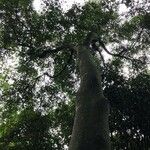Tree up to 40 m by 60 cm. Bark smooth, whitish; branchlets slender, pale brown, pubescent, glabrescent. Leaves chartaceous, sub-coriaceous, glabrous, sometimes pubescent beneath, glabrescent, shining on both surfaces, elliptic-oblong to oblong-lanceolate, 7½-12 by 2½-5¼ cm; base acute, attenuate, or obtuse; apex acuminate, acumen up to 2 cm; nerves 12-16 pairs, rather irregular, often branched, curving upward, elevated beneath, plane or obscure above, veins distinct beneath, invisible above; petiole 4-6 mm. Inflorescences terminal, axillary or supra-axillary, sometimes on internodes, usually branched with 2 or 3 umbels and each with about 10 flowers, more rarely a simple umbel; peduncle or common peduncle 5-15 mm; pedicels slender, 3-6 mm. Flowers green or dirty-yellow, cam-panulate, 5-6 mm long, scattered puberulous outside. Floral tube nearly glabrous within, distinctly 10-ribbed. Calyx lobes ovate-oblong, 2-3 mm long, densely puberulous within, almost as long as the tube, reflexed. Petaloid appendages oblong or slightly ovate-oblong, c. 1 mm long, slightly incurved, densely pilose. Stamens 1.25-2 mm long, the episepalous ones longer than the others; anthers linear, obtuse, as long as or shorter than the filaments. Ovary ovoid, 1-1.5 mm long, densely pubescent; style obscure; stigma capitate. Fruits obovoid or obovoid-oblong, rounded at the apex, cuneate to the base, 3-4 by 2.5 cm, usually compressed, pubescent outside, glabrescent; pericarp woody, the suture face c. 6 mm wide. Seed proper ovoid, including the beak 10 by 6 mm, densely covered with red hairs, the beak c. 4 mm long, the appendage twisted and as long as the seed, separated from it by a short, thin, stipe-like constriction.
More
A small tree. It grows up to 40 m high. It spreads 3-12 m wide. The trunk is pale and thin and smooth. Young shoots are silky. The leaves are alternate and leathery. They are 5-9 cm long and sword shaped. They are pointed and the veins are parallel and faint. The flowers are in white topped clusters. The fruit are 2-4 cm long and egg shaped. They are velvety. The seed are oval and covered with red hairs.


